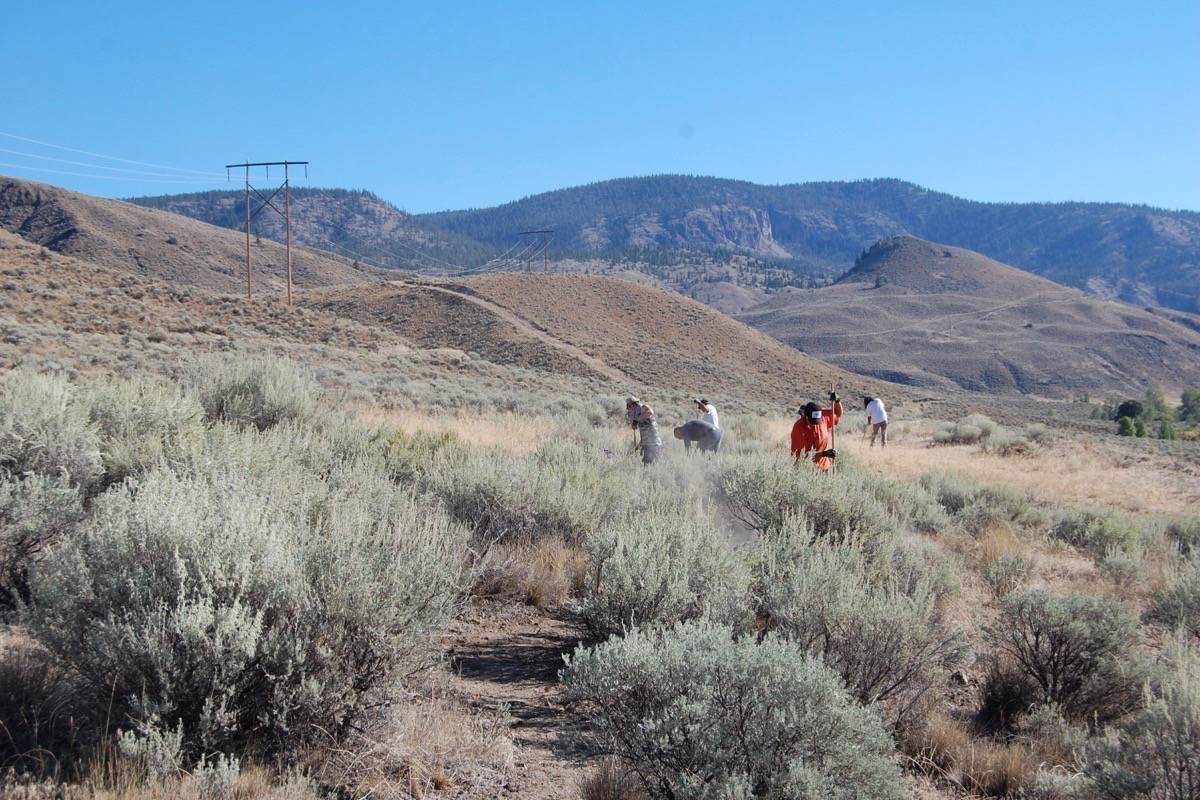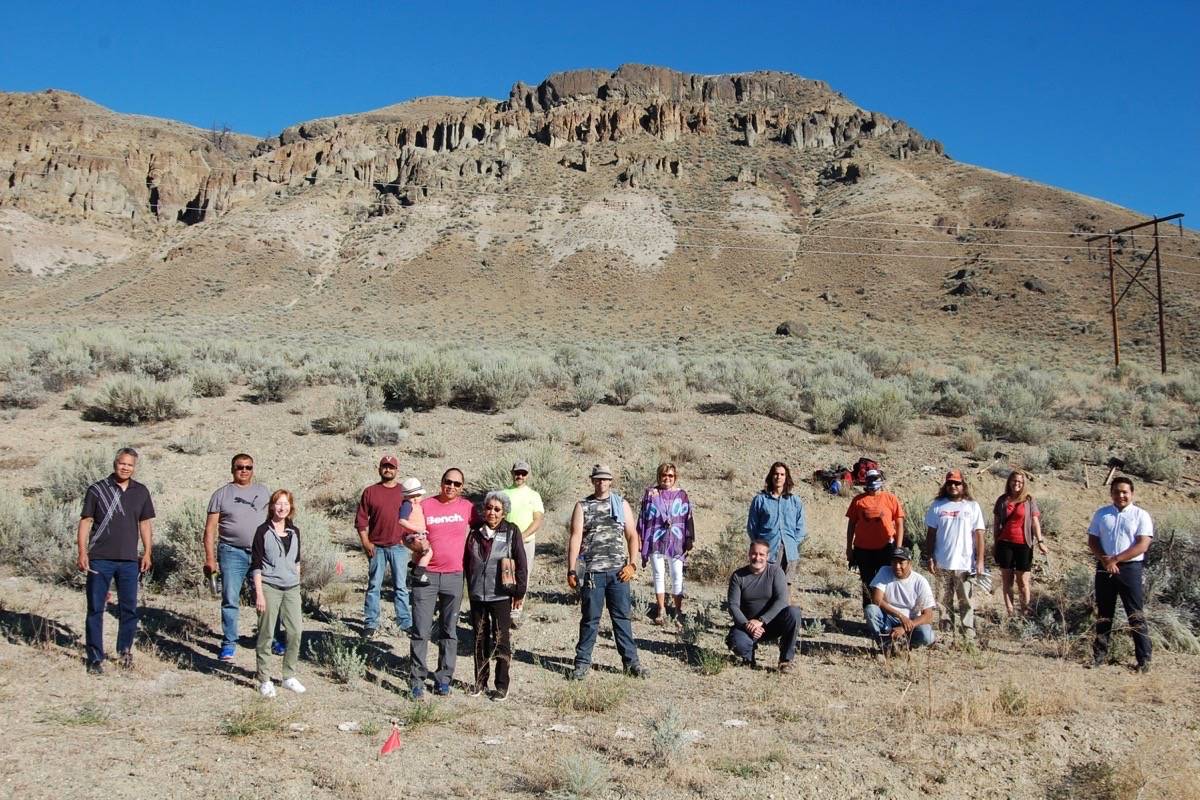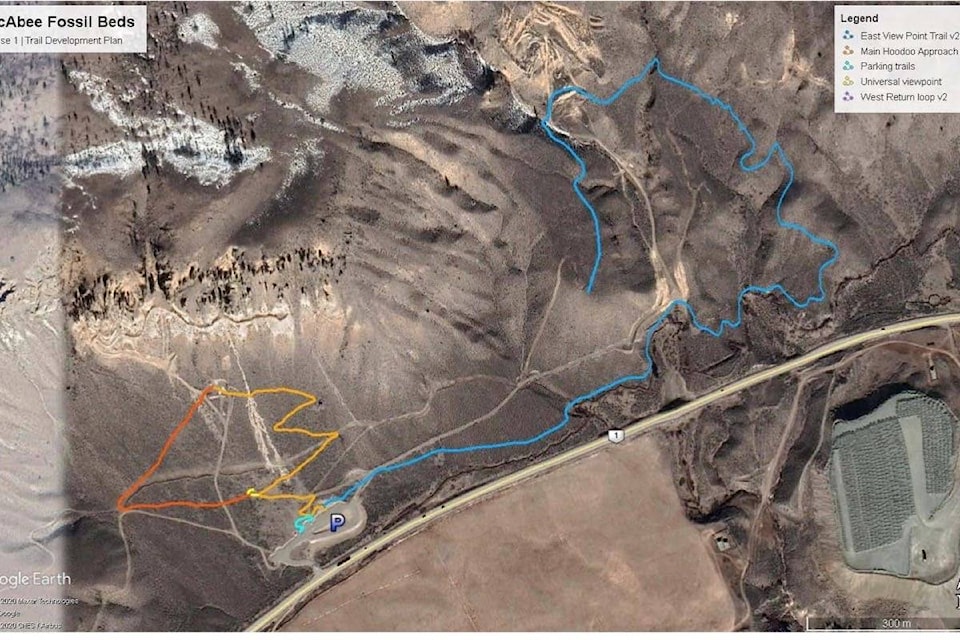A new phase of work at the McAbee Fossil Beds site, 12km east of Cache Creek, began on Sept. 9 and has now wrapped up for the year, resulting in the completion of the first of several planned trails through the site.
It’s a start on development that Deb Arnott, general manager of Community Futures Sun Country, feels could be a game-changer for McAbee and for the region. Sun Country oversees the project, in partnership with the Heritage Branch of the Ministry of Forests, Lands, and Natural Resource Operations and the Bonaparte Indian Band, and Arnott says that continued development at the site could encourage tens of thousands of visitors per year and lead to a huge economic boost for the area.
Under the supervision of Jacob “Sutra” Brett of Shuswap Trail Alliance, a crew of workers spent six weeks on phase one of the trail project at McAbee, which is the most diverse site in B.C. for plants and insects of the Eocene Epoch of more than 50 million years ago, and is recognized worldwide for its importance.
The site was in private hands for many years, before being acquired by the Province in 2012, declared a Heritage Site, and closed to the public. A working group of local stakeholders was formed in 2016 to push for the reopening and development of the McAbee Fossil Beds as a centre for visitors and researchers. In summer 2019 the site reopened to visitors, and while it stayed closed this past summer due to COVID-19, work began on trail construction for when the site is able to reopen.
“We’ve finished phase one of the trails, which is a natural loop that takes about two hours to complete,” explains Arnott.
“Work is on hold now because of the weather, and the goal is to start working on capped trails [topped with gravel] in spring 2021, with bridges and lookout points. That will mean bringing small equipment to the site, and I’m really excited about that, but we’re waiting to see with the pandemic where we’ll be next year.”
That will be phase two of the trails project, and Arnott says that Brett has done some quotes for phases three and four. “We wanted to be proactive and get the quotes so that we’re ready for funding, because you never know when that will come about.”
Work on the first phase of the trails was done by hand, and Arnott says the team did a great job.
“They did a lot of digging and raking during hot, hot weather. This first trail is a natural one that goes down a ravine and then comes up and around again. It takes two hours to walk the whole trail, and it’s nice for people wanting to stretch their legs, who can get a beautiful view of the area.”
Brett says that he did a survey of the whole site to come up with a trail plan that contained various options and different types of trails. “What sort of experience do you want to deliver? Once you understand that you can see what’s possible based on user experience and what people want to do. Some want to be here for 20 minutes, others for two hours.”
The building of trails at the site has been on the cards for several years, and at the start of work on Sept. 9 Elizabeth Deom — who was formerly with the Heritage Branch and has been associated with McAbee for several years — said that it was an important moment.
“It’s been a lot of work to get to this point. It’s a site where you can see history from 50 million years ago and how it connects to today. And we don’t want to build trails for the sake of it. We want to tell the story of the site, how the fossils got here, and tie that to today and to First Nations history.”
“We want to honour the people and history, and be respectful,” says Brett. “We don’t just want to bulldoze. We’ll be using the sage we take away and giving it to the [Bonaparte] Band, and using wilderness trails to explore the site with interpretive spots along it so people can see what it was like 50 million years ago, appreciate the environment, First Nations history, the settlers.”
The potential of the McAbee Fossil Beds as a tourism attraction was highlighted during the recent provincial election campaign, when the BC Liberals announced that, if elected, they would commit $2 million to develop McAbee as a tourist destination.
The Liberal statement noted that a 2017 business plan drawn up for McAbee suggested a phased approach to development, which would include a world class interpretive and research centre. The business plan noted that a conservative estimate put the number of visitors such a centre would attract at 50,000 per year.
Even though the Liberals will not form government, Arnott is hopeful that the site can still get funding.
“There is a lot of work to do with infrastructure, trails, and an interpretive centre. This is community economic development. We need to have individuals coming to the region. That keeps the economy moving and the hospital open, because doctors and nurses will come to the area because it’s a vibrant community. We have a lack of doctors and nurses wanting to relocate here, and we can’t keep the hospital open if we don’t have staff.
“We need a vibrant region where people want to move. If we get that economic stimulus it makes it easier to attract people here. We want to see more new money coming into the region. I appreciate everyone is shopping locally, and that’s awesome, but we need new dollars coming here.”
Arnott says that when the working group started she spoke with other sites that were very similar to McAbee to glean some of their knowledge. “When I told them we’d done a business plan that said 50,000 visitors a year, they laughed and said ‘You’re kidding, Deb; you’ll see a lot more than that.’
“I’m trying to make people take this seriously. With the location we have, the services we have, the new money coming in would provide our businesses with the money they need to make upgrades, improve their façades. Without money they can’t do that.”
She adds that it could lead to Cache Creek, Ashcroft, and the surrounding area becoming a bedroom community for Kamloops.
“It all makes sense, once people start coming this way. Unfortunately, people go the other way, along the Coquihalla. I’m amazed at how many people have never even driven into Ashcroft who live an hour away. People come to my office and say ‘We’re here.’ They stay for lunch, look around, and say ‘This is an incredible place.’
“We need to talk positively. Don’t talk about what we don’t have, talk about what we do have and focus on that. If we’re going to whine and complain, why would anyone want to relocate here or come here and start a business?
“People need to think of themselves as ambassadors. You’re more than a community citizen; you need to share all the positive things going on.”
One of those positive things is the work at, and potential of, the McAbee Fossil Beds.
“I have a passion for the site, and I’m making sure it keeps moving forward,” says Arnott. “It’s one of our many opportunities, along with Historic Hat Creek. If we had those two sites, those two flagships, people would start jumping on board. The McAbee site covers so much, and everything fits so well together. It’s incredible.”
editorial@accjournal.ca
Like us on Facebook and follow us on Twitter


